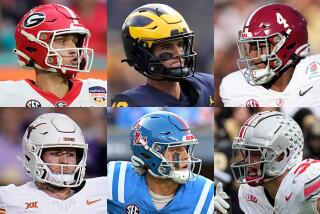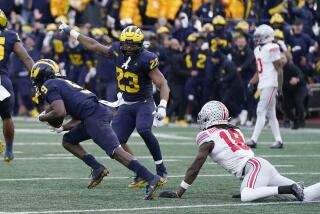Half a Century Later, Football Poll Still Causing Controversy
- Share via
There was one little town in Minnesota where they hung me in effigy. --ALAN J. GOULD, former AP sports editor recalling the furor his personal college football rankings created in 1935. My husband and I think that it is stupid and sad that the AP poll doesn’t know its job well enough to know that Alabama is and always will be No. 1. What does AP really stand for, Always Prejudiced? --Letter to the AP from a disgruntled Alabama fan after the Crimson Tide slipped behind Ohio State in the final 1979 regular-season poll. Not much has changed over the years when it comes to reaction to The Associated Press college football poll. And the final 1985 voting, the 50th anniversary poll, could raise another uproar.
If third-ranked Oklahoma (10-1) defeats top-ranked Penn State (11-0) in the Orange Bowl; if second-ranked Miami (10-1) and the only team to beat Oklahoma, defeats Tennessee in the Sugar Bowl; and if fourth-ranked Iowa (10-1) knocks off UCLA in the Rose Bowl, who is No. 1?
If you want someone to blame for the poll, that man is Alan Gould, now 87 and living in retirement in Florida.
Although he solicited opinions “from the AP staff and friends,” Gould’s Top 10 rankings in the early 1930s were essentially a one-man operation. His final 1935 ratings boiled down to Minnesota (8-0), Princeton (9-0) and SMU (12-0).
“I ranked them all together at the top,” Gould recalled not too long ago. “It created a storm in the Big Ten, in general, and Minneapolis-St. Paul, in particular. They thought theirs was the dominant team.
“There were some cases where agitated Minnesota followers wrote the general manager of the AP telling him he should get rid of me because I couldn’t tell one top team from another.
“It was a case of thinking up ideas to develop interest and controversy between football Saturdays. Papers wanted material to fill space between games. That’s all I had in mind, something to keep the pot boiling. Sports then was living off controversy, opinion, whatever. This was just another exercise in hoopla.
“Making it a Top 10 was an arbitrary decision. It seemed logical to confine it to that number. It was tough enough to pick a Top 10 in those days, let alone 15 or 20.”
Several of Gould’s friends, led by Cy Sherman of the Lincoln (Neb.) Star, suggested that he make it a poll of sports editors instead of a personalized list. And so the AP poll was born in 1936.
Through the 1964 season, the national champion was determined after the regular season. After that, the first post-bowl poll was taken--and it cost No. 1 Michigan State, a Rose Bowl loser, the national championship.
The poll went back to regular-season games in 1966 and 1967 before a permanent post-bowl poll was adopted in 1968.
The AP lines up a panel of 60 voters each season, people who cover college football for AP member newspapers and radio and TV stations. The basic rule of thumb allots one-half vote for every Division I-A school in a state. There also are three national voters--this year from ABC-TV, ESPN and Sports Illustrated.
Except for the national voters, the selection process--at one time every AP member could vote--is left up to the bureaus covering each states. So is the decision whether to keep the same people from year to year.
No AP employee votes in the poll. The AP merely counts the ballots, which somehow doesn’t seem to placate letter-writers who usually start out, “How could you . . . “
When Hayden Fry was coaching at North Texas State, he constantly petitioned AP Southwest sports editor Denne Freeman to vote for his team.
“I kept telling him I didn’t have a vote,” Freeman says. “And he’d say, ‘Yeah, but we’re playing pretty well. You really should vote for us.’ ”
Some facts about the AP poll:
--Twenty teams have been ranked in each poll except for the period from 1961-67, when 10 teams were listed each week.
--Notre Dame has won the most national championships (seven), followed by Oklahoma and Alabama (five each) and Minnesota (four). In all, 24 teams have won the national championship; Minnesota was the first one (1936).
--Notre Dame has been ranked the most times (452 of a possible 604), followed by Ohio State (438), Texas (425) and Michigan (415). But Michigan holds the record for appearing in the most consecutive polls (160 from 1968-80), followed by Notre Dame (159 from 1964-75) and Oklahoma (156 from 1971-81).
--Notre Dame also has been ranked No. 1 most often (69 times), followed by Ohio State (62), Oklahoma (52) and USC (47). USC was ranked No. 1 the most consecutive weeks--18, the last 14 weeks of 1972 and the first four of 1973.
--Notre Dame was No. 7 in the very first poll (Oct. 19, 1936) but wasn’t even in the Top 20 a week later.
--No team has ever held the No. 1 ranking from the preseason through the post-bowl poll. In 1971, Nebraska was No. 1 in every poll but the preseason one (so was USC in 1972) and in 1983 Nebraska was No. 1 in every poll but the post-bowl one.
--The only teams to be No. 1 in each and every poll were Notre Dame in 1943 and Army in 1945, but those were only regular-season polls, nine each year.
--The preseason poll began in 1950 and only six teams have been ranked No. 1 in the preseason and post-bowl polls in the same year--Tennessee in 1951, Michigan State in 1952, Oklahoma in 1956, 1974 and 1975, and Alabama in 1978--but all fell from the top spot somewhere along the way.
The biggest controversy occurred as a result of that final regular-season poll in 1979.
The nicer letters from Alabama began “Dear Scrooge” and “To What Big Dummy It May Concern,” and signed off “Hatefully,” etc. Some are too vulgar to mention.
“It was the kind of controversy I had in mind for the appeal of the poll,” Gould says, “but I had no idea it would reach such proportions.”
The other major wire service poll, conducted by United Press International, is a vote of coaches. While the AP poll allows voters to select from all teams playing Division I football, the coaches’ poll bans consideration of teams on NCAA probation.
That difference led to controversy earlier this year, when Florida--on probation--was ranked No. 1 in the AP poll the 10th week of the season. Penn State was No. 1 in the UPI poll, No. 2 in the AP list.
Columns were written and broadcast editorials aired over the propriety of allowing a team being punished for breaking the rules to be counted in the poll. But the firestorm abated when Florida was upset the following week by Georgia and Penn State took over as No. 1 in both major rankings.










